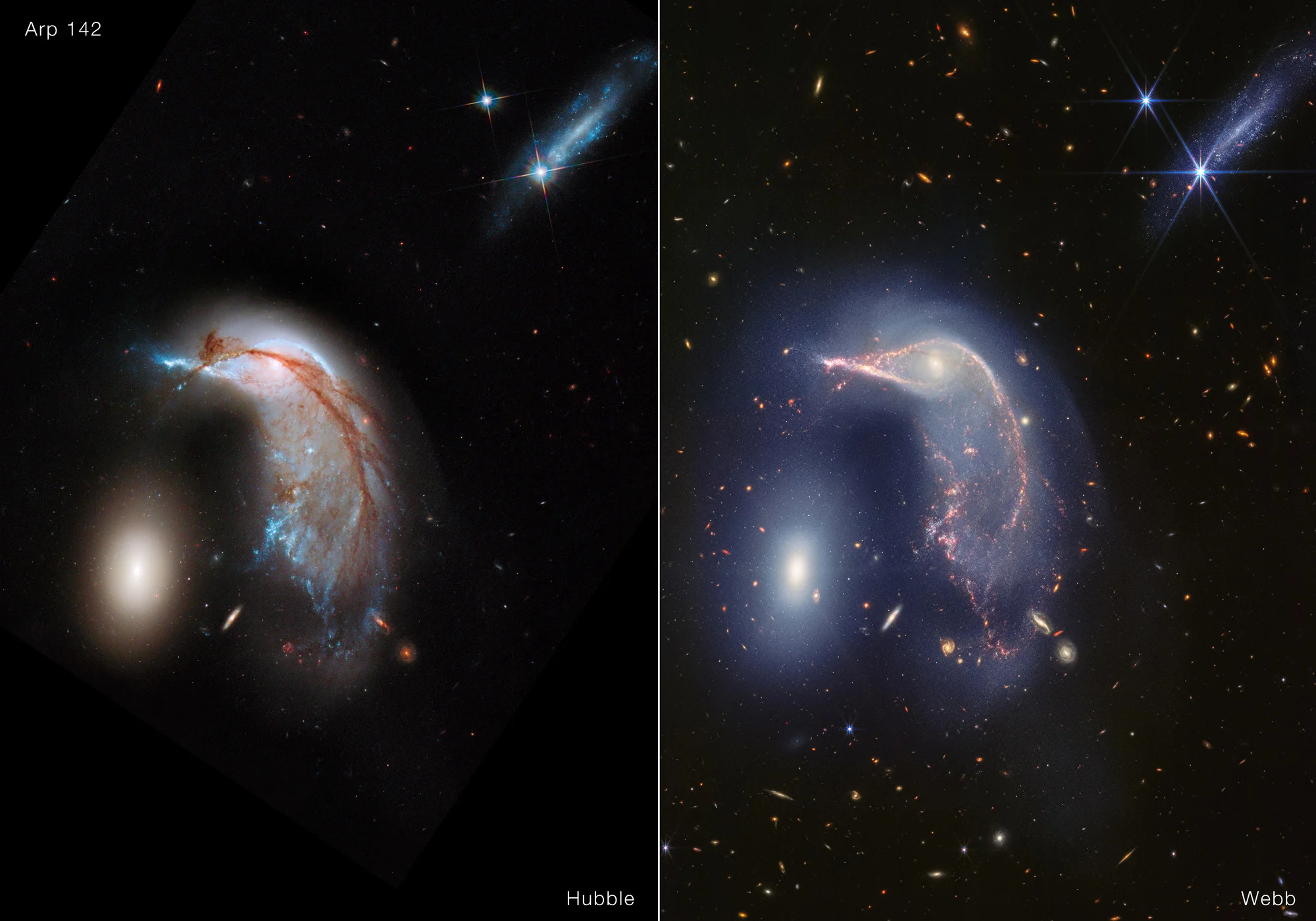According to NASA: "Before their first approach, the Penguin held the shape of a spiral. Today, its galactic center gleams like an eye, its unwound arms now shaping a beak, head, backbone, and fanned-out tail. Like all spiral galaxies, the Penguin is still very rich in gas and dust. The galaxies' 'dance' gravitationally pulled on the Penguin's thinner areas of gas and dust, causing them to crash in waves and form stars. Look for those areas in two places: what looks like a fish in its 'beak' and the 'feathers' in its 'tail.' Surrounding these newer stars is smoke-like material that includes carbon-containing molecules, known as polycyclic aromatic hydrocarbons, which Webb is exceptional at detecting. Dust, seen as fainter, deeper orange arcs also swoops from its beak to tail feathers."
"In contrast, the Egg's compact shape remains largely unchanged. As an elliptical galaxy, it is filled with aging stars, and has a lot less gas and dust that can be pulled away to form new stars. If both were spiral galaxies, each would end the first 'twist' with new star formation and twirling curls, known as tidal tails. Another reason for the Egg’s undisturbed appearance: These galaxies have approximately the same mass or heft, which is why the smaller-looking elliptical wasn't consumed or distorted by the Penguin."
Our best look at Arp 142 before this came from the Hubble Space Telescope.

Hubble's view of Arp 142 from June 22, 2012 (left) is shown next to Webb's new look, captured on May 6, 2024 (right). (NASA, ESA, CSA, STScI)
Hubble showed us the intricate lanes of dust embedded in the Penguin (NGC 2396), as well as the bright halo of dust and gas surrounding the Egg (NGC 2397). However, Webb peers straight through all of that obscuring matter to reveal the billions of stars contained in both galaxies.
Additionally, while Hubble gave us hints of what is in the background of this region of space, Webb's view shows us so much more! Nearly every splotch or point of light outside of the Penguin and Egg is a galaxy unto itself, containing billions of stars of its own!
"In just two years, Webb has transformed our view of the universe, enabling the kind of world-class science that drove NASA to make this mission a reality," Mark Clampin, director of the Astrophysics Division at NASA Headquarters, said in the press release. "Webb is providing insights into longstanding mysteries about the early universe and ushering in a new era of studying distant worlds, while returning images that inspire people around the world and posing exciting new questions to answer. It has never been more possible to explore every facet of the universe."
Watch below: See the amazing new 3D Pillars of Creation from NASA
https://news.google.com/rss/articles/CBMihAFodHRwczovL3d3dy50aGV3ZWF0aGVybmV0d29yay5jb20vZW4vbmV3cy9zY2llbmNlL3NwYWNlL3dlYmItdGVsZXNjb3BlLWNlbGVicmF0ZXMtYW5uaXZlcnNhcnktd2l0aC1uZXctcGVuZ3Vpbi1hbmQtZWdnLWdhbGF4eS1tZXJnZXLSAQA?oc=5
2024-07-13 02:41:00Z
CBMihAFodHRwczovL3d3dy50aGV3ZWF0aGVybmV0d29yay5jb20vZW4vbmV3cy9zY2llbmNlL3NwYWNlL3dlYmItdGVsZXNjb3BlLWNlbGVicmF0ZXMtYW5uaXZlcnNhcnktd2l0aC1uZXctcGVuZ3Vpbi1hbmQtZWdnLWdhbGF4eS1tZXJnZXLSAQA
Tidak ada komentar:
Posting Komentar